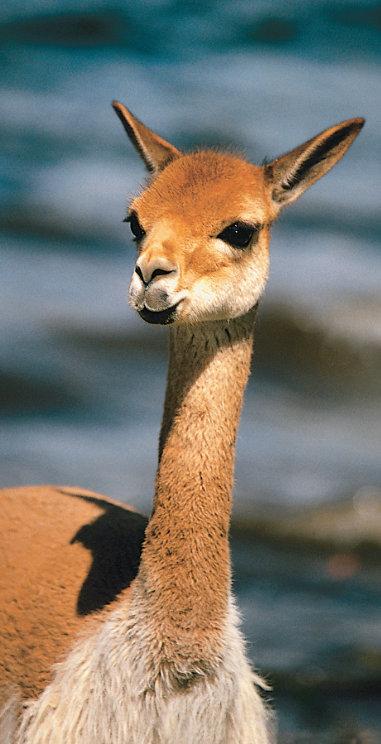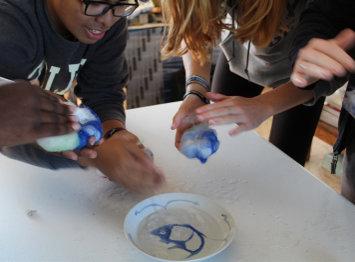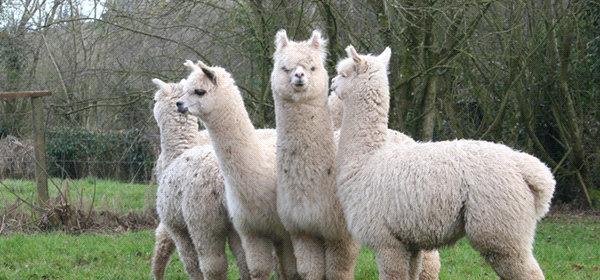
12 minute read
Vicuna Museum
The world’s first boutique Museum devoted to the Vicuña

Advertisement
We present Sol Vicuña. Michell & Compañía and their retail brand Sol Alpaca pay tribute to the history, tradi�on and heritage of the vicuña - a wild, delicate, elegant and deligh�ully free animal na�ve to the Peruvian Andes; and, especially, to the inhabitants of the Peruvian highlands, with whom it was to generate a very close, in�mate and, eventually, permanent connexion.

Located in the city of Cuzco, the famous historic capital of Peru, the Sol Vicuña Bou�que Museum is a milestone in Peruvian culture as Sol Alpaca is the world’s first brand to encapsulate the tex�le tradi�on of an en�re country within an inspiring and sophis�cated space. This unique museum is specially designed to offer an unforge�able experience to visitors, both local and foreign, who wish to enjoy an enriching encounter with a tex�le tradi�on over 5000 years old.
Luxury is based on experiences. Sol Vicuña offers an educa�onal trip from the beginnings of history up to our present day by means of complete and detailed informa�on that explains the evolu�on of the vicuña, the ancient Andean ritual of shearing - the Chaccu - the uses and exploita�on of the fibre, the sustaina- bility of the species and other interes�ng historical facts. The unique experience offered by Sol Vicuña is achieved and complemented by its alliance with the Amano Museum - the first museum of Pre-Columbian tex�les in Peru - in a space where �me goes by unno�ced while a close-up view is given of an invaluable collec�on of historic items; they a�est to the Wari culture’s rela�onship with the vicuña and how its fibre was used before the arrival of the Spanish conquerors.
Sol Vicuña also offers beau�ful accessories made from 100% vicuña, the world’s finest and most exclusive fibre. These fine ar�cles possess not only elegance, warmth, excep�onal so�ness, beau�ful drape and a magical, unique lustre but also characteris�cs linked to Nature, culture, technology and crea�ve work.
Backing of the Michell Group
The Peruvian firm Michell & Compañía is the world’s largest alpaca tex�le business, being ver�cally integrated from the raising of alpacas to the selling of products to final consumers.
Michell & Compañía is proud to contribute to the rescue of the paradigma�c vicuña. Not only do we believe in its beauty but we also share a love for its history, promo�ng its breeding in a way that protects and respects Nature. The effort, commitment and devo�on addressed to the protec�on of this lovely animal, together with all the people that surround its tex�le history, are translated, presented and celebrated through Sol Vicuña, enabling the vicuña fibre, the world’s finest, to be shared once more with the en�re human race.

The real treasure of the Andes
Wild, delicate and elegant; deligh�ully free, and na�ve to the Peruvian Andes.
Facing the sun while feeding on its mother’s milk, the vicuña presides over the highlands; indeed, it could even be said that its domains include the clouds and the limitless skies because it inhabits the high, starry regions at more than 5000 metres above sea level.

The golden fleece
Vicuñas have a beau�ful golden coat, thick and so�, which enables them to keep warm in the cold highland climate. Healthful proteins such as kera�n make up the main part of their wonderful fibre, a gi� from Nature and unsurpassed in quality and texture; it is superior even to the fibres produced by the Kashmir goat in the Himalayas.
The Peruvian Inca Empire was the most sophis�cated poli�cal organiza�on within the pre-Columbian universe and, in large measure, the camelids were the basis for the development of this imperial people. Camelids were used as beasts of burden, as a source of meat, and as providers of fibre for making warm clothes. Among them, the vicuña was considered a sacred animal by this society which respected, above all, Mother Earth. The animals were shorn without suffering any harm in a procedure known as the Chaccu, a ceremony full of mys�cism, offerings and happiness with moments of true religious gra�tude when the fibre of the gods was collected.
The Spanish conquest of the Inca Empire brought an end to a society in which the central concept was Mother Nature, repre- sen�ng the principal religious virtue.

The South American camelids, and par�cularly the vicuñas, almost reached the point of ex�nc�on. New species were introduced from Europe, bringing diseases with them and consuming the natural pasture. Hungry men, condemned to working in the mines and deprived of their beliefs, turned to hun�ng the vicuñas in order to survive.
It is es�mated that during the Spanish viceroyalty almost two million vicuñas were eliminated.
Rescue of the Vicuña
Although several laws had been made to protect the vicuña during the Republican era of Peru, indiscriminate poaching increased steadily so that, by 1960, it was es�mated that only 5000 vicuñas remained in Peru;
A shameful ex�nc�on event seemed imminent.
Thanks to the perseverance of some dis�nguished Peruvians, Na�onal Reserves in Ayacucho and Arequipa were established in the la�er part of the 1960s. Even so, the rescue of the vicuña turned out to be no easy task and a coordinated interna�onal effort was required in order to accomplish it.
This is how, during the 1970s, the basis of formal worldwide protec�on for the animal was established through the Vicuña Conven�on signed by Peru, Bolivia, Ecuador and Chile and the inclusion of the vicuña as a species with a high risk of ex�nc�on in the list compiled by CITES (Conven�on on Interna�onal Trade in Endangered Species of Wild Fauna and Flora) to prohibit the hun�ng of the vicuña and the sale of its products.
In 1995, the Peruvian government set up regula�ons regarding the treatment of vicuñas and their status as commercial property; the rural communi�es were acknowledged as those chiefly responsible for the conserva�on, care and beneficial use of the vicuñas.
Fortunately, it may now be said that the vicuña has been saved from ex�nc�on. Peru is home to 80% of the planet’s vicuña popula�on, and the animals are cared for in accordance with a strict set of rules. This has enabled their beau�ful fibre to reappear in the world’s most pres�gious shop windows.

By Cari Corley - Alta Vida Alpacas USA



On this gorgeous fall day, I am si�ng here watching our last gang of cria. They have so much youthful, playful energy. They chase each other. They check on each other. There is usually a bully but there is always one that sets the group straight and gets them all pronking together again, and this years’ gang is no excep�on. Our youngest cria, Amelia, is the smallest but tries her best to keep up and o�en in her quest to keep up her upper body gets ahead of her legs and she goes tumbling only to spring right back up and con�nue her quest. These moments are some of my ranch favorites. Another one of our favorite ranch moments is watching a group of young visitors experience this sight for the first �me. Watching nature have fun is powerful!
Our cria gang dynamics are not much different than a group of young people. We have had the privilege to host many people to our ranch young and old. Combining the youthful, playful energy of cria with the youthful, playful energy of kids is a synergis�c experience I encourage all to try. It can be overwhelming to host a group of young people if you have not had much experience working with youth. There are three principles I would encourage you to adopt if you choose to host a group of young people.

1. Plan the work, work the plan. Your plan should include a �med schedule, but it also needs to include a list of supplies that are needed for the group and a list of supplies that need to be prepared for each individual. These supplies need to be prepared ahead of �me so that as your visitors arrive you are ready to spend �me welcoming each of them. We host a fibre camp each summer and our plan and to-do list prepara�on begins months in advance. If you have more than one adult helping host the event (which I HIGHLY recommend), delegate the work according to each persons’ speciality. Each of us have our own skill sets and when the work is split up by areas of strength the workload feels lighter.
2. 80/20 Rule. There are so many great things that can be done on a ranch tour. Our favourite is to have our visitors create something with alpaca fibre or yarn. We also have a walking trail with educa�onal sta�ons where visitors can learn about alpacas, their fibre and their care. Young people love to move and interact much like our cria. We have had visitors create art from raw fibre and create art from alpaca yarn. When hos�ng youth we follow an 80/20 rule. 20% of the �me is instruc�on and explana�ons, and 80% of our �me should be hands on le�ng these young minds imagine, create, and interact. O�en, as adults, we err by spending too much �me talking or instruc�ng. A wri�en out schedule allows us to be inten�onal and mindful of the amount of �me we have planned for instruc�on and for crea�on and movement.
3. Be present, be adap�ve. When your visitors arrive, take a deep breath and be fully present. Every plan has moments you need to adjust and adapt. Remember that when working with youth, being 100% engaged in their alpaca experience goes a long way to crea�ng a successful event. Youth are very forgiving. It needs to be said again, youth love to imagine, create, and interact. At the end of the event they will remember the crea�ve community �me. They will remember interac�ng with each other and with our wonderful animals. They will not remember if our wonderfully cra�ed plan needed to be adjusted or had flaws. They will remember the �me spent with you. It is so important that our youth have �me spent with adults where we just enjoy them and our �me spent with them. Adjustments will need to be made to every plan. If every adjustment priori�zes compassion and community, you will host a successful event!
Objec�ve: Par�cipants will create a zipper pull or key chain flair using the Kumihimo braiding method. Allow two hours.
Materials Needed (per par�cipant):
Kumihimo disk
Zipper Pull Hardware (9 mm split ring and 1” lanyard hook)
2” piece of yarn for center �e
Ziploc bag for supplies
Pre-cut yarn strands -- mul�ple colors - each strand should be approx 38 cm (15 inches).
Approx Time Allo�ed:
1. 10 - 15 min - Si�ng in a circle, go around and introduce each other with a fun ques�on for each par�cipant to answer.
2. 10 min - Show and Tell - Pass around some braid projects you have completed and share the history of Kumihimo braiding.
a. History of Kumihimo Link h�ps://www.interweave.com/ar�cle/beading/kumihimoorigin-facts/
b. Tutorial Video Link h�ps://youtu.be/suUcFpj4OsA



4. 10 min - Distribute supplies
a. Have each par�cipant choose four, 38cm (15”) strands
b. Pass out bag of supplies
Photographs courtesy of Cari Corley
Cari Corley has fallen in love with all things fibre! Cari had no idea when they purchased their ini�al alpacas she was beginning a crea�ve journey that would open a world of possibili�es and a community of (com)passionate makers. Cari oversees all things fibre at Alta Vida Alpacas and develops the fiber curriculum for their non-profit, Alpaca Partners. Cari is passionate about exploring career opportuni�es for individuals with special needs in the fibre arts. She is a born maker. (In her spare �me...she teaches High School math and sponsors Na�onal Honor Society.)
Wet fel�ng soap is a fun and messy - yet clean! - ac�vity enjoyed by all ages.
You will need:

• a selec�on of carded, feltable fibre (huacaya and wool
work great for this, suri less so unless mixed with another fibre)
• one or two bars of soap per par�cipant
• hot water
• cold water
Begin by having your par�cipants lay out the fibre they want on the outside of their soap in a single, very thin layer, just large enough to wrap around the soap. Have them align the fibres in one direc�on. Have them then lay out two addi�onal, very thin layers on top of the first, with each layer’s fibre perpendicular to that below it. If the layers are too thick, the fibre won’t felt down properly.

Wrap the bar in your fibre layers. Star�ng with either cold or hot water, the par�cipants should gently pat the fibre all over the soap bar with damp fingers un�l it begins to cling together. Adding water as needed, begin rubbing the bar all over in both back and forth and circular mo�ons (don’t forget the corners!). Once the fibre begins to shrink, “shock” it by immersing the bar quickly in whichever temperature water you did not start with, and con�nue rubbing. If mess is a worry, put the bar of soap in a ziploc baggie to contain the suds.

Con�nue alterna�ng hot and cold water with rubbing un�l the fibres have shrunk �ght to the bar of soap. It’s now ready to let dry and then use - soap and a gently exfolia�ng washcloth all in one. Like all soaps, your felted soap should be allowed to dry out between uses. The felt will not mold or mildew, and will con�nue to shrink as you use your bar.

Many thanks to RaQuion Braxton, Kate Burke�, Meredith Keenan, Josua Lu�an and Riley Whitmyer for allowing me to document their soap making fun!
Photographs courtesy of Jill McElderry-Maxwell.











